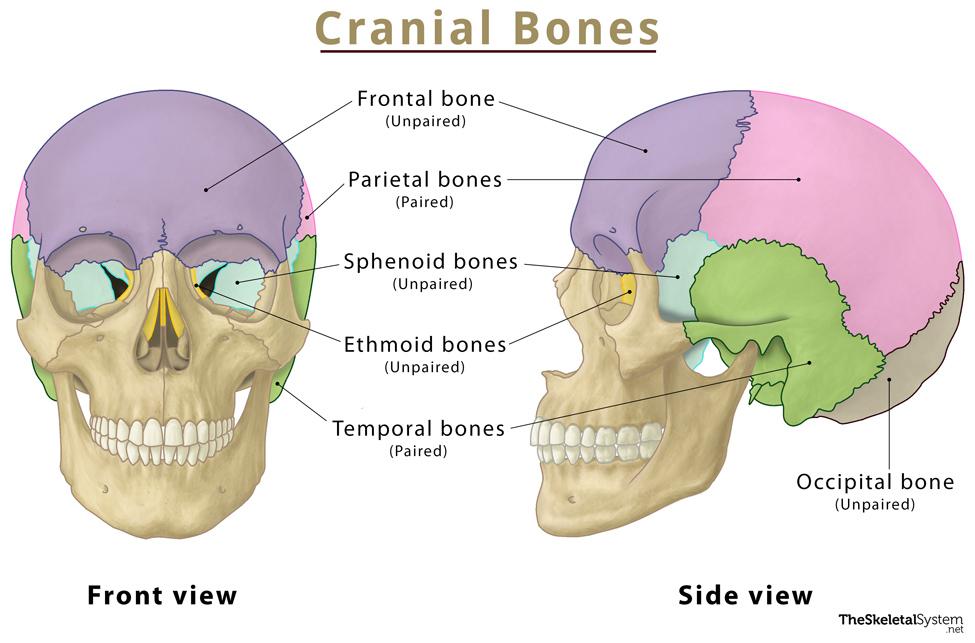Cranial Bones
What are the Cranial Bones
Out of the 22 bones that form the human skull, 8 bones encase the brain. These are called cranial bones, collectively referred to as the neurocranium or braincase. Some of these bones are flat, while some are irregular. As stated, the neurocranium encloses and protects the brain and forms the shape of the head.
Where is the Neurocranium Located
It is located at the top of the head. You can easily feel this structure by running your hand on the crown of your head.
How Many Cranial Bones are There and What are They
As mentioned, there are 8 cranial bones that are listed below:
- Frontal bone (Unpaired)
- Occipital bone (Unpaired)
- Parietal bones (Paired)
- Ethmoid bone (Unpaired)
- Temporal bones (Paired)
- Sphenoid bone (Unpaired)
Functions
As we know, all the cranial bones fuse to form the neurocranium to perform the following functions:
- Protecting the brain from any external injury or shock.
- Providing a surface for the facial muscles to attach.
- Allowing the passage of the cranial nerves necessary for our day-to-day functioning, such as seeing, smelling, and chewing.
Anatomy of the Cranial Bones
The neurocranium is somewhat spherical, mostly resembling a baseball cap. Anatomically, it is divided into two parts:
Cranial Roof: Also known as calvarium, this part of the neurocranium is formed by the frontal, occipital, and two parietal bones.
Cranial Base: It is composed of the frontal, sphenoid, ethmoid, occipital, parietal, and temporal bones.
Here are the individual bones that form the neurocranium:
1. Frontal Bone: An unpaired flat bone that makes up the forehead and upper part of the eye sockets.
2. Occipital Bone: Another unpaired flat bone found at the back of the skull. It has an opening through which the spinal cord passes and connects to the brain.
3. Parietal Bones: A pair of flat bones located on either side of the head, just behind the frontal bone. It protects the brain lying underneath.
4. Ethmoid Bone: Another unpaired irregular bone located in front of the sphenoid bone that forms a part of the nasal cavity.
5. Temporal Bones: A paired bone, located under each of the parietal bones. However, unlike the previous, these are irregular bones. These bones protect auditory nerves and a few ear structures that control hearing and balance.
6. Sphenoid Bone: An unpaired irregular bone located just below the frontal bone. It forms a large part of the skull base, as it spans the width of the skull. The sphenoid articulates with all the other cranial bones, as well as with the facial bones zygomatic, palatine, and vomer, thus connecting the neurocranium to the facial skeleton.
Joints Between the Cranial Bones
These 8 bones are held together by unique, immovable joints, called sutures, made of thick connective tissues. The irregular shapes of these joints allow all the uniquely shaped cranial bones to join. The sutures do not fuse until adulthood, so the brain continues growing as a person grows.
Cranial Bones Mnemonic
Here are some sentences that will help you to remember the names of these cranial bones:
- Eight Osseous Parts Form The Skull.
- Ethan’s Fried Spanish Pasta Tempted Octavia
Another easy phrase would be ‘STEP OF 6’, where the 6 stands for six types of cranial bones.
The bold letters in these sentences and phrase correspond to each cranial bone’s name. Here’s what it looks like:
E: Ethmoid bone
O: Occipital bone
P: Parietal bones
F: Frontal bone
T: Temporal bones
S: Sphenoid bone
Ossification and Development of the Cranial Bones
The cranial bones are developed in the mesenchymal tissue surrounding the head end of the notochord.
FAQs
Ans. The three cranial bones that contain sinuses are the frontal, ethmoid, and sphenoid bones.
References
- Bones of the Skull – Teachmeanatomy.info
- The Skull – Courses.lumenlearning.com
- Axial Skeleton – Training.seer.cancer.gov
- Skull Cranial Bones – Getbodysmart.com
- Cranial Bones: Parts, Location and Function – Study.com


